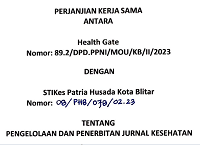The Role of Parenting Style Towards Bullying in Elementary School Age Children
Abstract
Full Text:
PDFReferences
Ahmad EB, V. Bullying and victimization: cause for concern for both families and schools. Social Psychology of Education. 2013.
O’Connell J. Bullying at school. California: Department of Education; 2013.
Martin C, & Colbert, KK. Parenting: a life span perspective. New York: McGraw-Hill Companies. Inc; 2013.
Olweus D. Bullying at school. USA: Blackwell Publishing; 2014.
Arsih F, ZUBAİDAH S, SUWONO H, GOFUR A. The exploration of educational value in Randai Minangkabau art, Indonesia. Journal for the Education of Gifted Young Scientists. 2019;7(4):1225-48.
Sullivan K. The Anti-bullying handbook. New Zealand: Oxford University Press; 2010.
Rigby K. Chidren and bullying: how parents and educators can reduce bullying at school. Australia: Blackwell Publishing; 2012.
Anderson C, & Carnagey, NL. Violent evil and the general affective aggression model New York: Gilford Publications; 2011.
Coloroso B. Stop bullying Jakarta: Porch of Universal Science; 2009.
Gaffar L. An introduction to professional nursing. Jakarta: EGC; 1999.
Notoatmodjo S. Health research methodology Jakarta: Rineka Cipta; 2012.
Brooks J. The process of parenting . (7th ed.). Boston: McGraw-Hill; 2012.
Djuwita R, editor The role of personal and situational factors on bullying behavior. Proceedings of the UI Psychology Scientific Meeting; 2012; Depok: UI Psychology.
Hetherington E, & Parke, RD. Child psychology: a contemporary viewpoint. (5th ed.). Boston: MC Graw-Hill; 2013.
Heath M, & Sheen, D. School-based crisis intervention: preparing all personnel to assist. New York: Gilford Press; 2012.
DOI: https://doi.org/10.70111/hg1203
Refbacks
- There are currently no refbacks.
"Health Gate"
ISSN 2986-1098
Indexing:
Published by The Regional Leadership Council of the Indonesian National Nurses Association, Blitar City
Kalimantan Street, Kel.Karangtengah, Kec. Sananwetan, Blitar City, East Java, Indonesia


.png)








